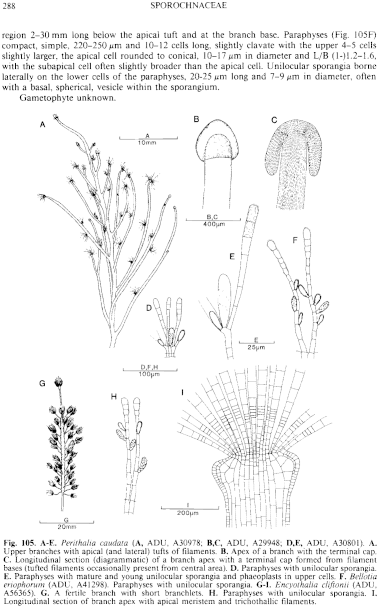|
|
|
|
|
|||||||||||
|
Electronic Flora of South Australia Species Fact Sheet
Phylum Phaeophyta – Order Sporochnales
Selected citations: Cribb 1960: 17, pl. 6 figs 1–8, pls 8,9. Lucas 1936:97, fig. 54. Womersley 1967: 237.
Thallus (Fig. 104B) medium to dark brown or green-brown, 5–20 (–25) cm long, with one to a few simple axes 3–8 (–15) cm long, becoming branched from their apices with clusters of 5–30 further branches, each 3–15 cm long, occasionally similarly branched again, all branches with prominent apical tufts of assimilatory filaments; attachment by a rhizoidal holdfast 2–6 mm across and 1–4 mm long; epilithic. Growth apical, with a broad, convex, branch meristem surmounted by the dense tuft of trichothallic filaments (0.5–) 1–2.5 cm long, each with a meristem 14–20 cells above their base, 50–65 µm in diameter above with cells L/B 2–3. Fronds (branches) fairly robust, 0.5–1 mm in diameter when sterile, usually tapering slightly to their base. Structure haplostichous and pseudoparenchymatous, with a broad medulla of elongate cells and a multilayered cortex, increasing by periclinal divisions, with the surface cells 6–8 µm across and L/B 1–2.
Reproduction: Sporangial sori surrounding the branches almost anywhere along their length, 1–7 cm long and (0.8–) 1–2 mm in diameter, usually (but not always) with a sterile region 2–30 mm long below the apical tuft and at the branch base. Paraphyses (Fig. 105F) compact, simple, 220–250 µm and 10–12 cells long, slightly clavate with the upper 4–5 cells slightly larger, the apical cell rounded to conical, 10–17 µm in diameter and L/B (1–) 1.2–1.6, with the subapical cell often slightly broader than the apical cell. Unilocular sporangia borne laterally on the lower cells of the paraphyses, 20–25 µm long and 7–9 in diameter, often with a basal, spherical, vesicle within the sporangium.
Gametophyte unknown.
Type from Port Phillip Heads, Vic.; in Herb. Harvey, TCD.
Selected specimens: Egg I., Isles of St Francis, S. Aust, 32–38 m deep (Shepherd, 11.i.1971; ADU, A38060). Off Waldegrave I., S. Aust., 21 m deep (Shepherd, 30.x.1983; ADU, A54501). Northern Spencer Gulf, S. Aust., 12 m deep (Shepherd, 6.ix.1973; ADU, A44449). Seal Bay, Kangaroo I., S. Aust., drift (Kraft, 4.xii.I 971; ADU, A41298). Investigator Str., S. Aust., 41 m deep, 35°24'S, 137°07'E (Watson, 14.i.1971; ADU, A38151). Robe, S. Aust., drift (Womersley, 7.ii.1970; ADU, A35175). Port MacDonnell, S. Aust., drift (Womersley, 16.x.1985; ADU, A57000). Lorne, Vic., drift ( Womersley, 23.i.1967; ADU, A31527). Port Phillip Heads, Vic. (Harvey, Alg. Aust. Exsicc. 48; NSW). Walkerville, Vic., drift (Sinkora A1579, 23.2.-9.3.1972; ADU, A43101; MEL). Rocky Cape, Tas., drift (Gordon, 18.i.1966; ADU, A29947). Satellite I., D'Entrecasteaux Ch., Tas., 12 m deep (Shepherd, 17.ii.1972; ADU, A41633).
Distribution: From Isles of St Francis, S. Aust., to Walkerville, Vic., and around Tasmania. Queensland (Noosa Hds, Alexandra Hds-Cribb 1960, p.18).
Taxonomic notes: B. eriophorum is a deep water plant on rough-water coasts or in areas of moderate currents. The occurrences in Queensland, but not in N.S.W., are unusual but they appear to be Bellotia eriophorum. Young plants with a single axis are morphologically the same as Tomaculopsis Cribb (1960, p. 18, pl. 7 figs 1–8).
References:
CRIBB, A.B. (1960). Records of marine algae from south-eastern Queensland. V. Pap. Dep. Bot. Univ. Qld 4, 3–31.
HARVEY, W.H. (1855a). Short characters of some new genera and species of algae discovered on the coast of the Colony of Victoria, Australia. Ann. Mag. Nat. Hist. 15, 332–336.
HARVEY, W.H. (1859a). Phycologia Australica. Vol. 2, Plates 61–120. (Reeve: London.)
HARVEY, W.H. (1859b). Algae. In Hooker, J.D., The Botany of the Antarctic Voyage. Part III. Flora Tasmaniae. Vol. 2, pp. 282–343, Plates 185–196.
LUCAS, A.H.S. (1936). The Seaweeds of South Australia. Part 1. Introduction and the Green and Brown Seaweeds. (Govt Printer: Adelaide.)
WOMERSLEY, H.B.S. (1967). A critical survey of the marine algae of southern Australia. II. Phaeophyta. Aust. J. Bot. 15, 189–270.
The Marine Benthic Flora of Southern Australia Part II complete list of references.
Publication:
Womersley, H.B.S. (14 December, 1987)
The Marine Benthic Flora of Southern Australia
Part II
©Board of the Botanic Gardens and State Herbarium, Government of South Australia
Illustrations in Womersley Part II, 1997: FIGS 104B, 105F.

Figure 104 enlarge
Fig. 104. A. Perithalia caudata (ADU, A27072). B. Bellotia eriophorum (ADU, A41298). C. Encyothalia cliftonii (ADU, A46855).

Figure 105 enlarge
Fig. 105. A–E. Perithalia caudata (A, ADU, A30978; B,C, ADU, A29948; D,E, ADU, A30801). A. Upper branches with apical (and lateral) tufts of filaments. B. Apex of a branch with the terminal cap. C. Longitudinal section (diagrammatic) of a branch apex with a terminal cap formed from filament bases (tufted filaments occasionally present from central area). D. Paraphyses with unilocular sporangia. E. Paraphyses with mature and young unilocular sporangia and phaeoplasts in upper cells. F. Bellotia eriophorum (ADU, A41298). Paraphyses with unilocular sporangia. G–I. Encyothalia cliftonii (ADU, A56365). G. A fertile branch with short branchlets. H. Paraphyses with unilocular sporangia. I. Longitudinal section of branch apex with apical meristem and trichothallic filaments.

|
Email Contact: State Herbarium of South Australia |

|